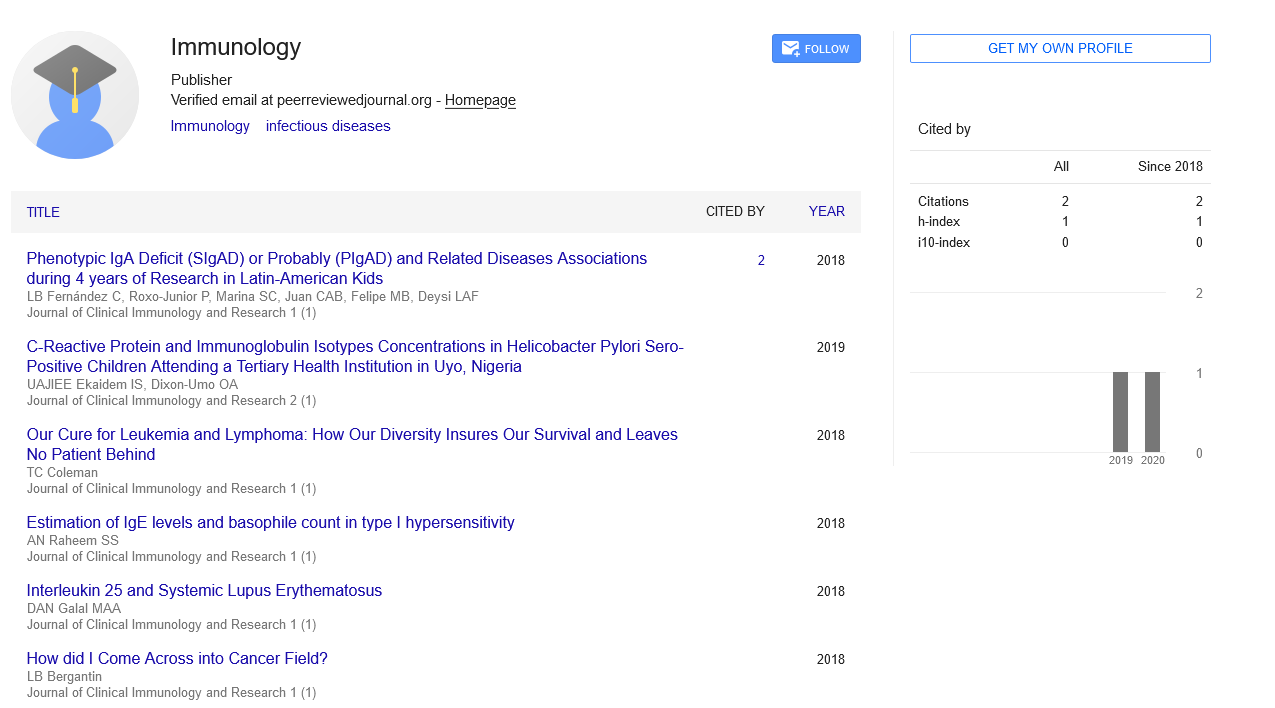Commentary, J Clin Immunol Res Vol: 6 Issue: 3
The Genesis of Inflammation and Immune Reactions: A Comprehensive Study
Jolian Cheng*
1Department of Hematology, Shanghai Jiao Tong University School of Medicine, Shanghai, China
*Corresponding Author: Jolian Cheng,
Department of Hematology, Shanghai Jiao
Tong University School of Medicine, Shanghai, China
E-mail: chengjolian67@sjtu.cn
Received date: 02 September, 2023, Manuscript No. JCIR-23-116291;
Editor assigned date: 04 September, 2023, PreQC No. JCIR-23-116291 (PQ);
Reviewed date: 18 September, 2023, QC No. JCIR-23-116291;
Revised date: 25 September, 2023, Manuscript No. JCIR-23-116291 (R);
Published date: 05 October, 2023, DOI: 10.4172/JCIR.100085.
Citation: Cheng J (2023) The Genesis of Inflammation and Immune Reactions: A Comprehensive Study. J Clin Immunol Res 6:3.
Abstract
Description
Inflammation and immune reactions are fundamental defense mechanisms employed by the body to protect against harmful agents, such as pathogens and tissue damage. However, dysregulation of these processes can lead to various diseases and disorders. Understanding the pathogenesis of inflammation and immune reactions is important for advancing our knowledge of disease mechanisms and developing targeted therapeutic interventions.
The innate immune response is the body's immediate defense mechanism against foreign invaders. It involves the recognition of Pathogen-Associated Molecular Patterns (PAMPs) by Pattern Recognition Receptors (PRRs). Activation of PRRs initiates a cascade of signaling pathways, including NF-κB and Mitogen-Activated Protein Kinases (MAPK) pathways, leading to the production of proinflammatory cytokines, such as Interleukin-1 (IL-1), Interleukin-6 (IL-6) and Tumor Necrosis Factor-alpha (TNF-α). These cytokines play a pivotal role in initiating inflammation and recruiting immune cells to the site of infection or tissue damage.
The adaptive immune response, characterized by specificity and memory, involves the activation of T cells and B cells. Antigens, foreign molecules recognized by the immune system, are presented to T cells by Antigen-Presenting Cells (APCs) via Major Histocompatibility Complex (MHC) molecules. This interaction activates T cells, leading to the differentiation of effector T cells (Thelper, T-cytotoxic) and regulatory T cells. B cells, on the other hand, differentiate into plasma cells and produce antibodies that target specific antigens.
One of the key features of the adaptive immune response is immunological memory. Memory T and B cells persist after an initial encounter with an antigen, providing long-term protection against reinfection. Upon subsequent exposure to the same antigen, memory cells mount a faster and more robust immune response, preventing the establishment of infection and controlling the inflammatory reaction.
Infectious diseases are often accompanied by inflammation and immune responses. In response to pathogenic microorganisms, immune cells release chemokines that attract other immune cells to the infection site. The recruitment of neutrophils and macrophages is critical for phagocytosis and clearance of pathogens. In chronic infections, persistent immune reactions can lead to tissue damage and contribute to disease progression.
Autoimmune diseases occur when the immune system mistakenly recognizes self-antigens as foreign and launches an immune attack against the body's own tissues. Rheumatoid arthritis, multiple sclerosis, and Systemic Lupus Erythematosus (SLE) are examples of autoimmune diseases. Dysregulation of T and B cells, breakdown of immune tolerance and abnormal cytokine production contribute to the pathogenesis of autoimmune diseases.
Allergic disorders are characterized by an exaggerated immune response to harmless substances (allergens) such as pollen, dust mites, or certain foods. When exposed to allergens, the immune system produces IgE antibodies, which trigger the release of histamine and other inflammatory mediators from mast cells and basophils. This leads to the characteristic symptoms of allergies, such as sneezing, itching, and swelling.
Inflammatory Bowel Disease (IBD), including Crohn's disease and ulcerative colitis, is characterized by chronic inflammation of the gastrointestinal tract. The exact cause of IBD is not fully understood, but it involves a complex interplay between genetic susceptibility, dysregulated immune responses, and environmental triggers. Inflammatory cytokines play a central role in tissue damage and perpetuation of the disease.
Tumors can evade the immune system through various mechanisms, allowing them to grow and spread unchecked. Immune checkpoints, such as PD-1/PD-L1 and CTLA-4, are regulatory pathways that down regulate immune responses to prevent excessive tissue damage. Cancer cells can exploit these checkpoints to suppress antitumor immune responses, making them a target for immune checkpoint inhibitors.
Conclusion
The pathogenesis of inflammation and immune reactions is a complex and multifaceted process that plays a critical role in both health and disease. Understanding the interplay between the innate and adaptive immune responses, immunological memory, and the mechanisms underlying dysregulated immune reactions is essential for advancing medical knowledge and developing targeted therapies for a wide range of diseases, from infectious diseases to autoimmune disorders and cancer.
 Spanish
Spanish  Chinese
Chinese  Russian
Russian  German
German  French
French  Japanese
Japanese  Portuguese
Portuguese  Hindi
Hindi 